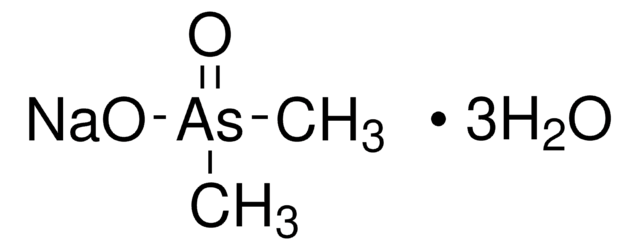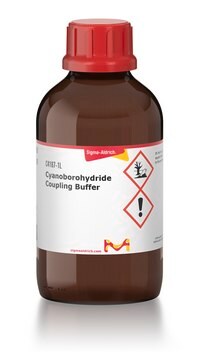G7651
Glutaraldeide
Grade I, 50% in H2O, specially purified for use as an electron microscopy fixative or other sophisticated use
Sinonimo/i:
Dialdeide glutarica, Pentano-1,5-diale
About This Item
Prodotti consigliati
Livello qualitativo
Tipo
Grade I
Forma fisica
liquid
Concentrazione
50% in H2O
tecniche
electron microscopy: suitable (fixative)
Colore
colorless
Punto di fusione
-21 °C ((-6 °F))
Solubilità
water: soluble
Condizioni di spedizione
dry ice
Temperatura di conservazione
−20°C
Stringa SMILE
[H]C(CCCC([H])=O)=O
InChI
1S/C5H8O2/c6-4-2-1-3-5-7/h4-5H,1-3H2
SXRSQZLOMIGNAQ-UHFFFAOYSA-N
Cerchi prodotti simili? Visita Guida al confronto tra prodotti
Categorie correlate
Descrizione generale
Applicazioni
- along with 4-(2-hydroxyethyl)-1-piperazineethanesulfonic acid (HEPES) buffer to fix the concentrated extracellular vesicles (EVs) on concanavalin A for scanning electron microscope (SEM)
- as a component in a solution to fix the cells to observe its morphology
- to fix the Escherichia coli cells in aqueous solution to preserve the surface morphology of bacterial cells
Azioni biochim/fisiol
Caratteristiche e vantaggi
- Highly efficient and safe to use with lensed instruments, rubber, or plastics
- Non-corrosive to metals
- Minimum shelf life of 14 days
Altre note
Esclusione di responsabilità
Avvertenze
Danger
Indicazioni di pericolo
Classi di pericolo
Acute Tox. 3 Inhalation - Acute Tox. 4 Oral - Aquatic Acute 1 - Aquatic Chronic 2 - Eye Dam. 1 - Resp. Sens. 1 - Skin Corr. 1B - Skin Sens. 1 - STOT SE 3
Organi bersaglio
Respiratory system
Rischi supp
Codice della classe di stoccaggio
6.1A - Combustible acute toxic Cat. 1 and 2 / very toxic hazardous materials
Classe di pericolosità dell'acqua (WGK)
WGK 3
Punto d’infiammabilità (°F)
Not applicable
Punto d’infiammabilità (°C)
Not applicable
Scegli una delle versioni più recenti:
Possiedi già questo prodotto?
I documenti relativi ai prodotti acquistati recentemente sono disponibili nell’Archivio dei documenti.
I clienti hanno visto anche
Il team dei nostri ricercatori vanta grande esperienza in tutte le aree della ricerca quali Life Science, scienza dei materiali, sintesi chimica, cromatografia, discipline analitiche, ecc..
Contatta l'Assistenza Tecnica.







